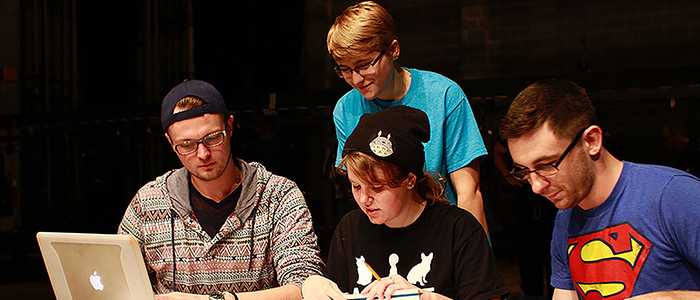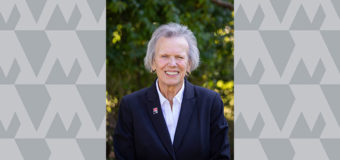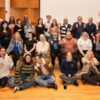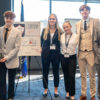ESU Presents Thornton Wilder’s Classic Our Town, October 13-16

Posted by: Elizabeth Richardson on October 3, 2016, No Comments
Photo Caption: Composer and sound designer, David Kunz, left, a senior technical theatre major from East Stroudsburg; master electrician Emma McDonough, a junior from Matamoras, Pa., majoring in technical theatre and English; assistant stage manager Nichole Seul, a junior from Milford, Pa., majoring in technical theatre and biochemistry; and assistant sound designer Travis Brewer, a senior from Nazareth, Pa., majoring in theatre with concentrations in both acting and directing, discuss coordinating sound and light cues for the East Stroudsburg University Theatre Department’s upcoming production of Our Town, October 13-16.
Playwright Thornton Wilder broke with realistic staging conventions by specifying that Our Town be presented on a bare stage with minimal props and set pieces. Now an American classic, the play was written in 1938 and continues to be performed as Wilder had intended.
“Though Wilder set the play in the fictional town of Grover’s Corner, N.H., in the early 20th century, he wasn’t aiming for realism,” noted Professor Susan P. O’Hearn, who is directing the East Stroudsburg University Theatre Department’s October 13-16 production of the drama.
“There is a feeling of being caught in time,” O’Hearn added. “We’re looking at a bare stage where characters are starkly represented, but we’re also are looking at mirrors of ourselves. The character of the Stage Manager, who sometimes is a part of the story and sometimes is isolated from it, highlights the theatricality of the drama.”
O’Hearn collaborated with composer and sound designer David Kunz, an ESU senior from East Stroudsburg, Pa majoring in technical theatre; lighting designer and technical director Christopher Domanski, associate professor of theatre; and scenic and costume designer Yoshi Tanokura, associate professor of theatre, to create the environment for the production.
“This is my first time writing music for a production,” Kunz said, “but, this year I had two major experiences that made me grow as a sound designer—my weeklong workshop at the Kennedy Center American College Theatre Festival national conference in Washington, D.C., and my summer internship with the Berkshire Theatre Festival. From both, I learned a tremendous amount from sound designers who wrote their own music for productions.”
Kunz, who said he “always has been passionate about music as a performer,” is using an electric keyboard and computer software to create “different themes to convey the musical atmosphere of the play, and, in some way, to instrumentalize what the town was like in the early 1900s.”
Since Wilder’s script contains specific sound cues, Kunz worked with two other theatre majors, Travis Brewer, a senior from Nazareth, Pa., who’s concentrating in acting and directing, and Colleen Brida, a sophomore from Northampton, Pa.., who’s concentrating in musical theatre. The duo researched historically accurate sounds to incorporate into the overall design. “This is very much a collective project,” Kunz noted. “I wouldn’t be able to do all this on my own.”
To better coordinate the sound and lighting, Kunz, who is also a work-study student in the theatre department, and Domanski extensively revamped the Smith-McFarland Theatre’s sound system so that sound and light seem to come from the same place.
“Lights tell the audience where to look, what emotions to feel, and how the story is developing,” Domanski said, “and sound does the same thing.”
Domanski added that “with no real scenery, lighting is asked to not only set the tone and mood of a scene, but also to define the locale; to make you feel you’re in a specific place even though there is no environment to light.”
Tanokura’s design challenge was to create an empty stage. “Because the Smith-McFarland Theatre has a thrust stage and stadium style seating, the floor becomes an important visual element,” he explained.
“As a designer, I didn’t want the audience looking at a black floor, so I searched for a hardwood floor and for design elements that enhance the story that the production team wants to tell,” Tanokura added.
“A good designer comes to production meetings with several ideas to tell the story of the play,” Domanski stated. “Working with the other designers and the director, you adjust your ideas to blend together and create a unity to the production.”
Curtain time for the ESU production of Our Town is 7:30 p.m. October 13-15 and 2 p.m. October 16. All performances are in the Smith-McFarland Theatre of the university’s Fine and Performing Arts Center, Normal and Marguerite streets, East Stroudsburg.
General admission for the production is $12; senior citizens, faculty and staff with ID are $10; students, with ID, are $7; and youth are $5. The production is recommended for ages 10 and above.
Tickets are available online in advance at esu.edu/theatretickets. Only credit cards are accepted online. Remaining tickets are available at the box office one hour before curtain on performance dates. Only cash and checks are accepted at the box office.
For reservations or other information, please email esuarts@esu.edu or call 570-422-3483.




